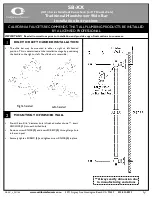
47
repeat the command, and move in another direction or pull back on the lead. As the dog begins to show a consistent response to
the command “Heel,” the e-collar can be used less often.
Be sure to give your dog a “freebie” now and then once he becomes more responsive, and always praise a job well done.
Teaching the “Here” Command with the Collar
This is perhaps the most important command that your dog will ever learn. The here command helps you maintain control of
the dog, and it allows you to pull him away from potentially dangerous situations. Due to its importance it is imperative that this
command be taught correctly. Therefore, you should only begin to teach the dog the here command with the collar after the dog
has been taught the sit/stay command and demonstrates that he understands the collar for the “Sit” and “Heel” commands.
As with the other phases of collar introduction you will begin stimulating the dog to “Here” on lead. You may even want to use
a “long line” or 20 foot leash. Begin by putting the dog on a sit/stay position and then moving away from him. Turn around to
face the dog and command “Here.” At the same time tug on the line and press a stimulation button briefly to help the dog move
toward you. Be sure to reward the dog with lots of praise whenever he comes after being called. As with the other commands,
you can start to introduce distractions as the dog’s proficiency increases.
Cautionary note: Teaching this command may be a little confusing to the dog at first. After all, in earlier training he got cor-
rected if he moved from the “Sit” position on his own. Now if he remains sitting when called he is getting corrected to make
him come to you. Therefore, consistency and patience are perhaps more important here than ever, together with plenty of
praise whenever he does it right.
Training with the Collar Only
After the dog begins to respond consistently to the command during collar conditioning, typically after about 5 or 6 training ses-
sions using the e-collar, you can remove the leash and train with just the e-collar. As the dog becomes more proficient with these
commands, you can begin to introduce distractions, such as rolling a ball in front of the dog or walking him in the presence of
others. Eventually in most training circumstances all your commands will be “freebies” (no stimulation given with the command).
You will use stimulation anytime you need to repeat a command because the dog did not obey the first one.



































